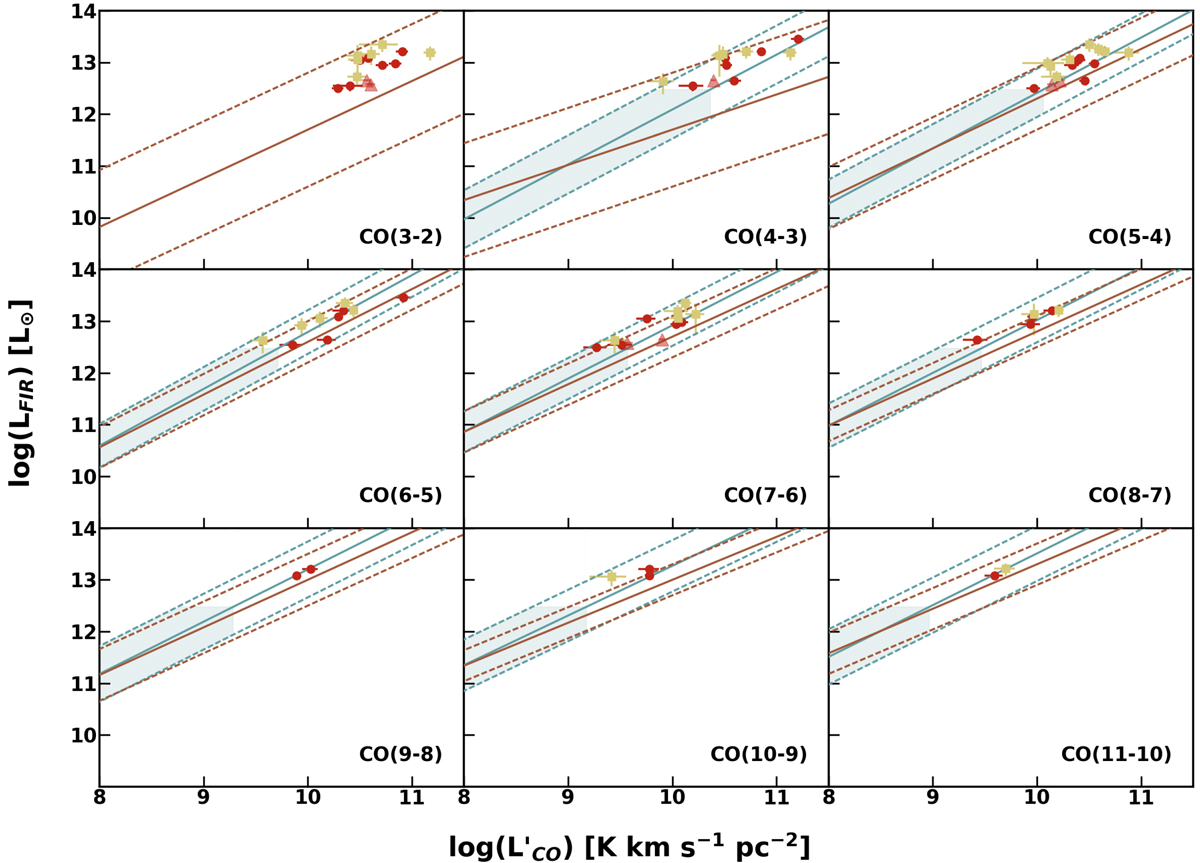Fig. 3.

Relations between LFIR and ![]() for the nine CO transitions detected at least in one of the Planck’s dusty GEMS. Red points show results from this work, corrected for the gravitational magnification and with error bars including the uncertainties on μ from Table 1. Red triangles mark the position of PLCK_G138.6+62.0 and PLCK_G200.6+46.1 which have more uncertain magnification factors. Yellow squares are the high-redshift strongly lensed SMGs from the H-ATLAS survey, also corrected for strong lensing magnification (Yang et al. 2017). Solid blue lines indicate the best linear fits obtained by Liu et al. (2015) for a diverse sample of local galaxies and individual star-forming regions with luminosities in the range 108 ≤ LFIR ≤ 1012L⊙, as shown by the blue shaded regions. Dashed blue lines show their ±2σ dispersions. Brown lines represent similar relations for low-redshift ULIRGs with 1011 ≤ LFIR ≤ 3 × 1012L⊙ presented in Kamenetzky et al. (2016). The properties of high-redshift SMGs are consistent with local relations and extend their validity over five orders of magnitude in FIR luminosity.
for the nine CO transitions detected at least in one of the Planck’s dusty GEMS. Red points show results from this work, corrected for the gravitational magnification and with error bars including the uncertainties on μ from Table 1. Red triangles mark the position of PLCK_G138.6+62.0 and PLCK_G200.6+46.1 which have more uncertain magnification factors. Yellow squares are the high-redshift strongly lensed SMGs from the H-ATLAS survey, also corrected for strong lensing magnification (Yang et al. 2017). Solid blue lines indicate the best linear fits obtained by Liu et al. (2015) for a diverse sample of local galaxies and individual star-forming regions with luminosities in the range 108 ≤ LFIR ≤ 1012L⊙, as shown by the blue shaded regions. Dashed blue lines show their ±2σ dispersions. Brown lines represent similar relations for low-redshift ULIRGs with 1011 ≤ LFIR ≤ 3 × 1012L⊙ presented in Kamenetzky et al. (2016). The properties of high-redshift SMGs are consistent with local relations and extend their validity over five orders of magnitude in FIR luminosity.
Current usage metrics show cumulative count of Article Views (full-text article views including HTML views, PDF and ePub downloads, according to the available data) and Abstracts Views on Vision4Press platform.
Data correspond to usage on the plateform after 2015. The current usage metrics is available 48-96 hours after online publication and is updated daily on week days.
Initial download of the metrics may take a while.


